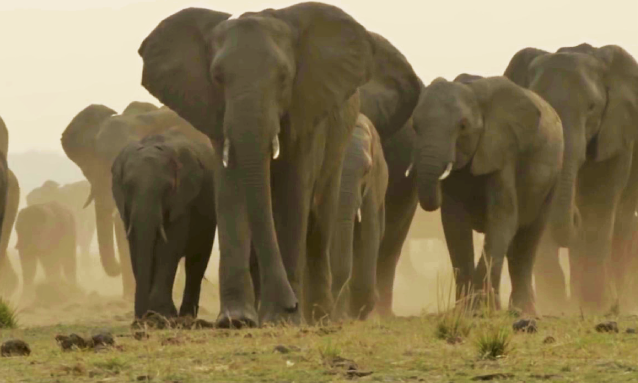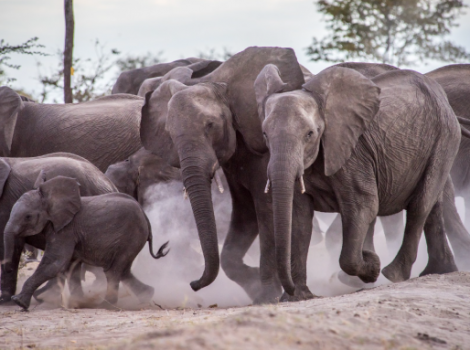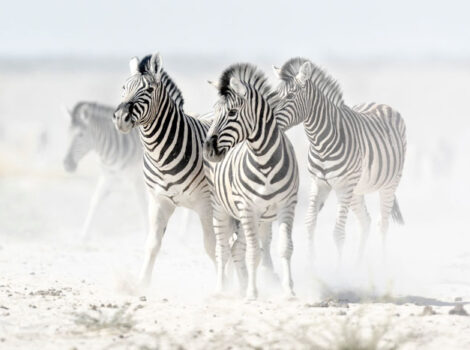
THEY WALK IN circles and appear dizzy before suddenly dropping dead, sometimes face-first. No one knows why. Over the past several months, hundreds of elephants have died in Botswana, some with these symptoms.
The bizarre behaviour and sheer number of deaths suggest to experts that it’s unlikely that diseases known to afflict wild elephants, such as tuberculosis, are to blame. The elephants’ tusks aren’t missing, which rules out poaching for ivory. Yet the death toll keeps growing. Government officials say they’ve verified that 281 elephants have died since March 2020; conservation NGOs in the area say the death toll is even higher.
“From a population perspective this is not serious, even though many elephants have died,” says Markus Hofmeyr, a wildlife veterinarian and former head of veterinary services at Kruger National Park.
“It is, however, important that there is a diagnosis made to make sure no foul play is at hand – that would be a problem for the population if it is not dealt with.”
Botswana, with an estimated 130,000 savanna elephants, is one of the species’ last strongholds in Africa, where ivory poaching has been responsible for reducing their numbers to roughly 350,000. The dying animals in Botswana lived in a roughly thousand-square-mile tract in a remote area northeast of the Okavango Delta, where an estimated 18,000 elephants, 16,000 people, and 18,000 cattle live.
According to veterinarians and wildlife experts interviewed by National Geographic, as well as an examination of past elephant die-offs, possible causes include: ingestion of toxic bacteria in water, anthrax poisoning, poisoning by humans, viral infection from rodents, or a pathogenic microbe. Then, too, it could be some combination of these causes – especially if environmental factors have played a part, such as this year’s late heavy rainfall after years of drought.
The Botswana government, which is investigating the mysterious deaths, announced at a press conference on July 10 that it has preliminary results from laboratory tests in Zimbabwe but is waiting to share them with the public, pending conclusive answers.
“We expect additional results from one other lab in South Africa later this week,” Cyril Taolo, Acting Director of Botswana’s Department of Wildlife and National Parks tells National Geographic.
“Results from Canada and the U.S. will follow thereafter.”
Experts say that getting an accurate explanation requires sampling carcasses and the soil and water in their vicinity almost immediately after the elephants die. That’s a daunting challenge in this remote area, where an elephant’s body may not be found and analysed for days or even longer. By then, the hot sun has helped degrade the body, likely erasing key evidence, and scavenging animals may eat organs before they can be recovered for examination.
Here’s a closer look at the possible causes and their significance:
Starvation or dehydration
It’s very unlikely that the animals succumbed to starvation or dehydration because the die-offs started when the waterholes were still full of rainwater, and the area they live in has an abundance of woodlands for browsing, says Erik Verreynne, a wildlife veterinarian and consultant in Botswana who directs a cattle herding program where the elephant deaths have occurred.
“The vegetation is lush and green after a much better rainfall year as compared to the drought of the previous years,” he says.
Toxins in the water
Cyanobacteria – blue-green algae – can be deadly, and many of the elephants have been found near waterholes or ponds. But elephants generally drink from the middle of water bodies – not the edges where cyanobacteria tend to accumulate. Moreover, with time rainfall typically washes out the bacteria, and the elephants have been dying in this region over several months. Cyanobacteria likely caused prehistoric mass elephant die-offs. It’s possible that the elephants in Botswana were sickened by something else and, perhaps feverish, craved water and died soon after drinking or trying to drink. The only way to confirm or rule out cyanobacteria is to test the waters, which Taolo says is underway.
Anthrax
Sudden deaths of elephants after showing neurological symptoms – such as walking in circles, as reported by eyewitnesses – suggests anthrax poisoning is a likely possibility. The bacterium that causes this infectious disease occurs naturally in soil and has been known to affect domestic and wild animals around the world. Elephants could become infected when they breathe in or ingest contaminated soil, plants or even water.
But Botswana’s Department of Wildlife and National Parks says it has eliminated anthrax as a possibility, though details about how remain scarce. South African wildlife veterinarian Michael Kock, who worked on elephant anthrax cases in this region for the Botswana government in the 1990s, says scientists would need to take blood samples from the animals ideally within hours after they died. Under the microscope, anthrax microbes have a distinctive shape, Kock says, but when a body begins to decay, other bacteria invade, which makes identification extremely challenging.
If anthrax is killing the elephants, it would be a difficult problem to stamp out, he adds. To prevent the spores from spreading, it’s necessary to burn the carcasses as soon as possible – requiring tons of wood. Given that the deaths have been occurring in such a remote region, with few roads, getting to all the carcasses would be an additional challenge. (The Department of Wildlife and National Parks has already burned some carcasses close to communities, Taolo says.) Although a vaccine against anthrax is given routinely to livestock such as cattle, administering it to 18,000 elephants is unrealistic, Kock says.
Poisoning
Could local people who live close to elephants have poisoned them in retaliation for eating their crops, perhaps by lacing waterholes or vegetables such as cabbages? If poison – typically cyanide – was used, the deaths would likely be clustered in a specific area, as seen here. But cyanide remains in carcasses long after death, and there’s no evidence that animals eating the bodies of the dead elephants – hyenas, jackals, vultures – are dying as well.
Other poisons, such as sodium fluoroacetate, which is sometimes used as a pesticide and breaks down more quickly, could be suspects. To verify this, Kock says, scientists would need to examine the victims’ liver, which acts as the body’s natural toxin filter, and stomach, where the potentially contaminated food might be testable.
If poisonings are to blame, authorities would likely want to work with communities that have suffered because elephants have damaged their land and crops. How best to manage encounters between humans and elephants is politically contentious. Last year, President Mokgweetsi Masisi lifted a five-year ban on hunting elephants, citing the need to reduce dangerous encounters.
Encephalomyocarditis virus
Sudden death preceded by neurological symptoms would be consistent with this rodent-borne virus, which causes heart failure. The virus is excreted in the faeces of rodents; elephants are at risk of eating contaminated grass.
“Most herbivores eat the blades of grass from above, but elephants kick out and consume the whole tuft – roots, rodent faeces, and all,” says South African wildlife veterinarian, Roy Bengis.
More than 60 elephants in Kruger National Park died this way during the early 1990s. It happened after the first wet year following a severe drought – conditions similar to those recently in Botswana – when the rodent population around South Africa’s famous park exploded, says Bengis, who was head of state veterinary services at Kruger at the time.
There have been no reports of unusually large numbers of rodents in the areas where Botswana’s elephants have died, however. According to Kock, froth in the elephants’ airways and specific signs of heart damage would point to this cause. It’s also possible to detect the virus itself during a necropsy. Encephalomyocarditis hasn’t been a priority for treatment or vaccine development, so if it’s to blame, there’s little recourse to counter it.
Killer microbes
Bacteria and viruses previously not deadly for specific species can evolve to become killers – as was the case with the novel coronavirus, SARS-CoV-2, which likely originated in bats and so far has killed more than 500,000 people worldwide. Many coronaviruses occur in animals, but there’s no evidence that COVID-19 is behind these elephant deaths, or that it even occurs in elephants, Kock says.
Sudden or extreme changes in weather, the landscape, or microbes’ hosts can trigger changes in bacteria or viruses, making them deadly. In 2015, some 200,000 saiga antelopes died from blood poisoning in Kazakhstan after extreme heat and humidity caused a common Pasteurella bacterium –which under normal conditions occurs harmlessly in the animals – to multiply and fatally overwhelm them. Something similar could be happening with the elephants, veterinarians say. But temperatures in the region haven’t been exceptionally high lately, and the deaths are still relatively confined, making this theory less likely.
“We have to keep an open mind,” veterinarian Verreynne says.
He notes that another possibility could be viruses transmitted by arthropods such as ticks or mosquitoes that have never been diagnosed in wild elephants before. Perhaps the area’s recent abundant rains, after years of drought, set the stage for an outbreak, he says.
Multiple factors, including climate change, could contribute to such die-offs.
“Disease is often an indicator of an underlying problem,” Verreynne says, adding that untangling what’s killing Botswana’s elephants “may assist in assessing the health of the ecosystem.”
Source: http://www.nationalgeographic.com/animals/2020/07/botswana-elephant-death-mystery/



